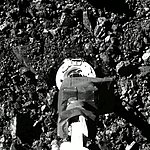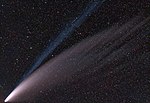Comet NEOWISE
 C/2020 F3 (NEOWISE) photographed from Germany on July 14, 2020 | |
| Discovery | |
|---|---|
| Discovered by | NEOWISE |
| Discovery date | March 27, 2020[1] |
| Orbital characteristics | |
| Epoch | 2458953.5 (April 14, 2020) |
| Observation arc | 113 days |
| Number of observations | 376 |
| Orbit type | Long period comet |
| Aphelion | 538 AU (inbound) 710 AU (outbound) |
| Perihelion | 0.29478 AU |
| Semi-major axis | 270 AU (inbound) 355 AU (outbound) |
| Eccentricity | 0.99921 |
| Orbital period | ~4500 yrs (inbound)[2] ~6800 yrs (outbound) |
| Inclination | 128.93° |
Longitude of ascending node | 61.01° |
| Argument of periapsis | 37.28° |
| Last perihelion | July 3, 2020 |
| TJupiter | −0.408 |
| Earth MOID | 0.36 AU (54 million km; 140 LD) |
| Jupiter MOID | 0.81 AU (121 million km) |
| Physical characteristics | |
| Dimensions | ~5 km (3 mi)[1] |
C/2020 F3 (NEOWISE) or Comet NEOWISE is a long period comet with a near-parabolic orbit discovered on March 27, 2020, by astronomers during the NEOWISE mission of the Wide-field Infrared Survey Explorer (WISE) space telescope. At that time, it was an 18th-magnitude object, located 2 AU (300 million km; 190 million mi) away from the Sun and 1.7 AU (250 million km; 160 million mi) away from Earth.[3]
NEOWISE is known for being the brightest comet in the northern hemisphere since Comet Hale–Bopp in 1997.[4] It was widely photographed by professional and amateur observers and was even spotted by people living near city centers and areas with light pollution.[5] While it was too close to the Sun to be observed at perihelion, it emerged from perihelion around magnitude 0.5 to 1, making it bright enough to be visible to the naked eye.[6] Under dark skies, it could be seen with the naked eye[7] and remained visible to the naked eye throughout July 2020.[8] By July 30, the comet was about magnitude 5,[9] when binoculars were required near urban areas to locate the comet.
For observers in the Northern Hemisphere, the comet could be seen on the northwestern horizon, below the Big Dipper. North of 45 degrees north, the comet was visible all night in mid-July 2020. On July 30, Comet NEOWISE entered the constellation of Coma Berenices, below the bright star Arcturus.
History and observations
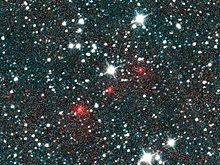
The object was discovered by a team using the WISE space telescope under the NEOWISE program on March 27, 2020.[1] It was classified as a comet on March 31 and named after NEOWISE on April 1.[3] It has the systematic designation C/2020 F3, indicating a non-periodic comet which was the third discovered in the second half of March 2020.
Comet NEOWISE made its closest approach to the Sun (perihelion) on July 3, 2020, at a distance of 0.29 AU (43 million km; 27 million mi). This passage through the planetary region increases the comet's orbital period from about 4500 years to about 6800 years.[2] Its closest approach to Earth occurred on July 23, 2020, 01:09 UT, at a distance of 0.69 AU (103 million km; 64 million mi) while located in the constellation of Ursa Major.[10]
In early July, the comet could be seen in the morning sky just above the north-eastern horizon and below Capella. Seen from Earth, the comet was less than 20 degrees from the Sun between June 11 and July 9, 2020. By June 10, 2020, as the comet was being lost to the glare of the Sun, it was apparent magnitude 7,[9] when it was 0.7 AU (100 million km; 65 million mi) away from Sun and 1.6 AU (240 million km; 150 million mi) away from Earth. When the comet entered the field of view of the SOHO spacecraft's LASCO C3 instrument on June 22, 2020, the comet had brightened to about magnitude 3, when it was 0.4 AU (60 million km; 37 million mi) away from the Sun and 1.4 AU (210 million km; 130 million mi) away from Earth.[9]
By early July, Comet NEOWISE had brightened to magnitude 1,[11][12] far exceeding the brightness attained by previous comets that year, C/2020 F8 (SWAN), and C/2019 Y4 (ATLAS). By July, it also had developed a second tail. The first tail was blue and made of gas and ions. There was also a red separation in the tail caused by high amounts of sodium. The second twin tail was a golden color and was made of dust, like the tail of Comet Hale–Bopp. The comet was brighter than C/2011 L4 (PanSTARRS),[citation needed] but not as bright as Hale–Bopp was in 1997. After perihelion, the comet began to fade, dropping to magnitude 2 in mid July.[13] Its nucleus activity subdued after mid-July, and its green coma was clearly visible after that.
On July 13, 2020, a sodium tail was confirmed by the Planetary Science Institute's Input/Output facility.[14] Sodium tails have only been observed in very bright comets such as Hale–Bopp and C/2012 S1 (ISON).
From the infrared signature, the diameter of the comet nucleus is estimated to be approximately 5 km (3 mi).[1] The nucleus is similar in size to Comet Hyakutake and many short-period comets such as 2P/Encke, 7P/Pons-Winnecke, 8P/Tuttle, 14P/Wolf, and 19P/Borrelly.[15] By July 5, NASA's Parker Solar Probe had captured an image of the comet, from which astronomers also estimated the diameter of the comet nucleus at approximately 5 km (3 mi).[16] Later in July 2020, other observations were also reported, including those related to coma morphology[17] and spectrographic emissions.[18][19][20] On 31 July 2020, strong detection of OH 18-cm emission was observed in radio spectroscopic studies at the Arecibo Observatory.[21] On August 14, 2020, the rotation period of the comet was reported to be "7.58±0.03 hr".[22]
A number of authors have suggested considering the comet a great comet.[23][24][25][26][27][28] Others have argued that it lacked the brightness and visible tail to qualify.[29]
Trajectory
Comet NEOWISE’s retrograde orbit crossed to the north of the plane of the ecliptic, to which it is inclined at approximately 129 degrees, on June 29, 2020, 01:47 UT.[11][30] It made its closest approach to the Sun (perihelion) on July 3, 2020, at a distance of 0.29 AU (43 million km; 27 million mi). This passage increases the comet's orbital period from about 4400 years to about 6700 years.[2] On July 18, the comet peaked at a northern declination of +48 and was circumpolar down to latitude 42N.[10] Its closest approach to Earth occurred on July 23, 2020, 01:09 UT, at a distance of 0.69 AU (103 million km; 64 million mi) while located in the constellation of Ursa Major.[10]
-
 Diagram of the comet's nearly parabolic orbit
Diagram of the comet's nearly parabolic orbit -
 Comet's position in the sky – the retrograde loops are caused by parallax from Earth's annual motion around the Sun; the most apparent movement occurs when the comet is closest to Earth
Comet's position in the sky – the retrograde loops are caused by parallax from Earth's annual motion around the Sun; the most apparent movement occurs when the comet is closest to Earth -
 Animation of C/2020 F3's orbit around Sun
Animation of C/2020 F3's orbit around Sun
C/2020 F3 · Sun · Mercury · Venus · Earth · Mars
Gallery
In chronological order:
-
 July 7, 2020, Golden Gate Bridge, California, United States
July 7, 2020, Golden Gate Bridge, California, United States -
 Inverted telescope image photographed on July 9, 2020
Inverted telescope image photographed on July 9, 2020 -
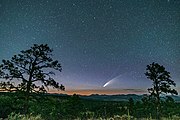 July 14, 2020 near the San Francisco Peaks in the Flagstaff dark sky preserve
July 14, 2020 near the San Francisco Peaks in the Flagstaff dark sky preserve -
 July 17, 2020, 18:59 UTC over Asterousia, Crete, as it entered into Ursa Major
July 17, 2020, 18:59 UTC over Asterousia, Crete, as it entered into Ursa Major -
 Comet C2020 NEOWISE 17-07-2020 20:51:57 UTC La Canada observatory
Comet C2020 NEOWISE 17-07-2020 20:51:57 UTC La Canada observatory -
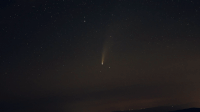 Midnight, July 18, 2020 – in a time-lapse taken from the Shenandoah National Park, Virginia, U.S. the view was rotating because the lens was on a tracking mount
Midnight, July 18, 2020 – in a time-lapse taken from the Shenandoah National Park, Virginia, U.S. the view was rotating because the lens was on a tracking mount -
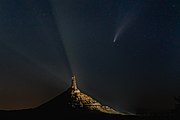 Above Chimney Rock on July 18, 2020
Above Chimney Rock on July 18, 2020 -
 July 19, 2020 in Villanovaforru (Sardinia, Italy)
July 19, 2020 in Villanovaforru (Sardinia, Italy) -
 NEOWISE from the Eastern Sierra Mountains – July 20, 2020
NEOWISE from the Eastern Sierra Mountains – July 20, 2020 -
 July 21, 2020 in Quebec, Canada
July 21, 2020 in Quebec, Canada -
 Joshua Tree National Park, a dark-sky preserve, on July 21, 2020
Joshua Tree National Park, a dark-sky preserve, on July 21, 2020 -

-
 Hubble image taken on August 8, 2020
Hubble image taken on August 8, 2020
See also
References
- ^ a b c d Mace, Mikayla (July 8, 2020). "Comet NEOWISE Sizzles as It Slides by the Sun, Providing a Treat for Observers". Infrared Processing and Analysis Center. Archived from the original on July 13, 2020. Retrieved July 13, 2020.
- ^ a b c JPL Horizons barycentric solution for epoch 1800 (before entering planetary region)
Goto JPL Horizons
1800-Jan-01 is "PR = 1.64 × 106/365.25 days" = 4490 years
2200-Jan-01 is "PR = 2.48 × 106/365.25 days" = 6789 years
(For long-period comets on multi-thousand year orbits, asymmetric outgassing will affect the highly sensitive orbital period and eccentricity.) - ^ a b "COMET C/2020 F3 (NEOWISE)". Minor Planet Electronic Circulars. 2020-G05. April 1, 2020. Archived from the original on July 15, 2020. Retrieved July 13, 2020.
On behalf of NEOWISE (C51), J. Masiero reported on March 31 UT that this object showed clear signs of cometary activity.
- ^ Dan Falk (July 9, 2020). "One of the brightest comets in decades is passing Earth. Here's how to see it". National Geographic. Archived from the original on July 10, 2020. Retrieved July 29, 2020.
- ^ Adam Mann (July 15, 2020). "Comet NEOWISE: How to See It in Night Skies". The New York Times. Archived from the original on July 28, 2020. Retrieved July 29, 2020.
- ^ Mark Armstrong (July 17, 2020). "Don't miss Comet NEOWISE in the evening". Astronomy Now. Archived from the original on July 19, 2020. Retrieved July 29, 2020.
- ^ "How to see Comet NEOWISE". EarthSky. Archived from the original on July 11, 2020. Retrieved July 11, 2020.
- ^ Seiichi Yoshida. "C/2020 F3 ( NEOWISE )". Archived from the original on May 14, 2020. Retrieved April 4, 2020.
- ^ a b c "C/2020 F3 (NEOWISE) plot @ Comet Observation database (COBS)" (mm.m column). Archived from the original on July 16, 2020. Retrieved July 18, 2020.
- ^ a b c "Horizons Web-Interface". ssd.jpl.nasa.gov. Archived from the original on July 8, 2020. Retrieved July 24, 2020. Ephemeris Type: Observer, Observer Location: Geocentric 500, Note: Closest approach occurs when deldot flips from negative to positive; Maximum northern declination is 2020-Jul-18 07h)
- ^ a b Dickinson, David (June 30, 2020). "Comet F3 NEOWISE May Perform in July". Universe Today. Archived from the original on July 15, 2020. Retrieved June 30, 2020.
- ^ "ATel #13853: Morphology and Photometry of Comet C/2020 F3 (NEOWISE) from SOHO". Astronomer's Telegram. July 2, 2020. Archived from the original on July 5, 2020. Retrieved July 10, 2020.
- ^ Nick James (July 6, 2020), "Visual observations page", Comet Section, British Astronomical Association, archived from the original on July 16, 2020, retrieved July 13, 2020
- ^ "NEOWISE: Rare Image of a Comet's Sodium Tail". Planetary Science Institute. July 13, 2020. Archived from the original on July 14, 2020. Retrieved July 14, 2020.
- ^ "JPL Small-Body Database Search Engine: numbered comets and diameter > 4 (km) and diameter < 6 (km)". JPL Solar System Dynamics. Archived from the original on July 15, 2020. Retrieved July 13, 2020.
- ^ Miloslav Druckmuller; Robert Nemiroff; Jerry Bonnell (July 11, 2020), The Tails of Comet NEOWISE, NASA, archived from the original on July 17, 2020, retrieved July 11, 2020
- ^ Manzini, Federico; et al. (July 21, 2020). "ATel #13884: Morphological Structures in the inner coma of comet C/2020 F3 (NEOWISE)". The Astronomer's Telegram . Archived from the original on July 24, 2020. Retrieved July 21, 2020.
- ^ Lin, Zhong-Yi; et al. (July 22, 2020). "ATel #13886: The Sodium Emission of comet C/2020 F3 (NEOWISE) observed at KenTing and Lulin observatory". The Astronomer's Telegram. Archived from the original on July 22, 2020. Retrieved July 22, 2020.
- ^ Krishnakumar, Arvind; et al. (July 26, 2020). "ATel #13897: CN, C2, C3 production rates of Comet C/2020 F3 (NEOWISE) as observed from Himalayan Chandra Telescope, Hanle, India". The Astronomer's Telegram. Archived from the original on July 27, 2020. Retrieved July 26, 2020.
- ^ Mugrauer, M.; Bischoff, R. (August 9, 2020). "ATel #13928: Follow-Up Spectroscopy of Comet C/2020 F3". Archived from the original on September 29, 2020. Retrieved August 10, 2020.
- ^ Smith, Allison; et al. (August 25, 2020). "ATel #13968: Strong detection of OH 18-cm emission from Comet C/2020 F3 (NEOWISE)". The Astronomer's Telegram. Archived from the original on September 29, 2020. Retrieved August 25, 2020.
- ^ Drahus, Michal; et al. (August 14, 2020). "ATel #13945: Rotation of Comet C/2020 F3 (NEOWISE)". The Astronomer's Telegram. Archived from the original on September 29, 2020. Retrieved August 18, 2020.
- ^ "Weekly Information about Bright Comets (2020 July 18: North)". Seiichi Yoshida. July 18, 2020. Archived from the original on July 19, 2020. Retrieved July 18, 2020.
- ^ "Seiichi Yoshida's Diary of Comet Observations (2020)". Seiichi Yoshida. July 19, 2020. Archived from the original on July 20, 2020. Retrieved July 19, 2020.
- ^ "Comet NEOWISE Updtae: Easy To See In The Evening! When And How To See Comet NEOWISE". Farmer's Almanac. July 18, 2020. Archived from the original on July 19, 2020. Retrieved July 19, 2020.
- ^ "APOD: 2020 July 13 – Comet NEOWISE Rising over the Adriatic Sea". NASA. July 18, 2020. Archived from the original on July 15, 2020. Retrieved July 19, 2020.
- ^ Jamie Carter (July 23, 2020). "Act Now For Your Best And Last Chance To See Comet NEOWISE This Weekend. Here's When, Where And How". Forbes. Archived from the original on July 29, 2020. Retrieved July 29, 2020.
- ^ "The Great Comet of 2020 (NEOWISE)". The University of Arizona's Mt. Lemmon Skycenter. July 23, 2020. Archived from the original on July 26, 2020. Retrieved July 29, 2020.
- ^ Rao, Joe (July 24, 2020). "The curtain is about to come down on Comet NEOWISE". Space.com. Archived from the original on July 26, 2020. Retrieved July 27, 2020.
- ^ "NEOWISE (C/2020 F3)". JPL, NASA. Archived from the original on July 27, 2020. Retrieved November 20, 2020.
External links

- C/2020 F3 (NEOWISE) – Comet Watch
- C/2020 F3 (NEOWISE) Archived July 16, 2020, at the Wayback Machine – AiM-Project-Group
- C/2020 F3 (NEOWISE) – Ernesto Guido & Adriano Valvasori
- Comet C/2020 F3 (NEOWISE) Information & Planetarium Archived July 19, 2020, at the Wayback Machine – TheSkyLive
- C/2020 F3 (NEOWISE) on YouTube – ISS view (video; 7:00; July 7, 2020)
- C/2020 F3 (NEOWISE) on YouTube – Tom Polakis; 300w rms/20mins (video; 0:10; July 7, 2020)
- C/2020 F3 (NEOWISE) – Seiichi Yoshida
- C/2020 F3 (NEOWISE) photo gallery – Mathew Browne
- Comet NEOWISE at the JPL Small-Body Database
- Close approach · Discovery · Ephemeris · Orbit diagram · Orbital elements · Physical parameters
- v
- t
- e
| Features |  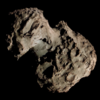 | |
|---|---|---|
| Types | ||
| Related |
| |
| Exploration | ||
| Latest |
| |
| Culture and speculation |
 Category
Category




















